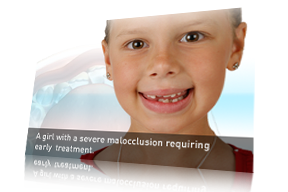
In every dental practice, the most common question asked by parents is, “When do I start treatment for my child?”
Whether you are primarily treating adults or children, parents will always ask about when to bring in their offspring for your inspection. On average, most dentists prefer to see children earlier rather than later, since dental caries is best treated early. Also, fissure sealants, fluoride treatment and other preventative measures are most effective when timed with early eruption of the permanent dentition. When a child has a thumb sucking habit, the doctor immediately advises treatment to eradicate the problem and prevent incorrect facial development. Early treatment is the consistent approach.
One would think that this consistency of treating dental problems as soon as they are detected would be practiced throughout the field of dentistry.
A strange phenomenon occurs when it comes to malocclusion. The myth is that orthodontic treatment is the sole domain of the orthodontist and must be delayed until the malocclusion is fully evident in the permanent dentition. The dentist assures the parent that the only option is to wait for the complete eruption of the permanent teeth and then apply fixed appliances and extract if required.
Parents are given this advice by their dentist, daily, in every dental practice. The “wait till later” orthodontic advice contradicts the “detect and treat early” principals, which are universally accepted in medicine and dentistry. We should question why this is so.
A child of 6 years of age will exhibit noticeable signs of the malocclusion he/she will have at 12 years. The myth that children ever grow out of malocclusion still persists in some minds, despite there being no scientific evidence to support it .(1) Parents see the early signs of crowding and Class II malocclusion and rush their growing child into your dental practice. You do an examination and say, “Well, your child’s teeth are crowded. There is not much I can do now but she will need braces in a few years”.

So why do we treat everything early except for orthodontic problems?
The main reason is because your orthodontist tells you to. But where is the scientific basis for this opinion and why should general dentists be following this advice that is contrary to the basic principles of primary medical and dental care? General dentists are often discouraged from performing early orthodontic treatment by the majority of the orthodontic profession. Like patients, dentists should be offered a choice for their treatments.
So is the only alternative to wait? Is there a viable alternative to braces?
For the last 100 years, functional appliances have been used with the mixed dentition to change form and function of the maxilla and mandible. They emanate from Eastern Europe, where they are still used today. Early treatment was proposed along the lines of, “you see it, you treat it”. Parents need to know you are giving them the correct advice. Is it possible to respond to the early treatment demand from parents?
Great patient and parent demand now exists for early treatment since this medical approach is communicated to us daily. Cancer, diabetes, heart disease - the common message is detect and treat early.
Furthermore, the majority of children have habits driving the malocclusion. Mouth breathing, tongue thrusting and incorrect swallowing patterns are all known causes of malocclusion and poor facial growth. If detected and treated early, better facial growth can be achieved.(2)
Dentists should respond to this growing demand and learn more about early treatment methods that have been in use for decades. Orthodontic skills for early treatment are not necessarily required and often orthodontic treatment with braces and extractions are not needed either, making you some money and saving the parent even more. The child benefits from the removal of bad habits that will potentially cause the development of incorrect facial growth and later TMJ problems. Clearly, this method of treating early with myofunctional appliances has many valuable benefits for all involved.
Written by: Dr Chris Farrell, BDS Sydney.
References:
1. Little RM. Stability and relapse: Early treatment of arch length deficiency. Am J Orthod Dentofacial Orthop. 2002;121:578-581.
2. S. Linder- Aronson, D.G. Woodside, A. Lundstrom, and J.Mc. William - Mandibular and maxillary growth after changed mode of breathing. Am Journal Orthod Dentofac Orthop 1991;100:1-18.
